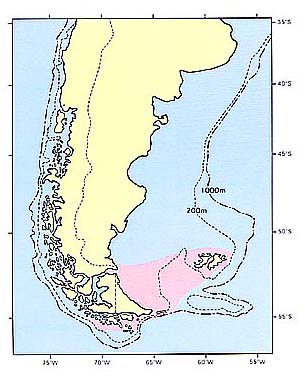ノトセニア科
- HOME
- デジタル図鑑
- パタゴニア海域の重要水族
- 硬骨魚綱 スズキ目
- ノトセニア科
ノトセニア科(Nototheniidae)

98 ウイルトンノトセニア(Uiruton-notosenia)
Patagonotothen wiltoni(Regan, 1913)
特 徴:
背鰭5棘,36軟条,臀鰭33軟条,胸鰭24軟条,腹鰭1棘,5軟条,鰓耙数8+0+17=25,鰓条骨数6,側線鱗数49(上列),11(下列),頭長は体長の26.5%,眼径は6.5%,体高は20.7%,吻長は6.4%,両眼間隔は3.6%,上顎長は8.4%,尾柄高は8.8%,胸鰭長は16.9%,腹鰭長は18.2%,第1背鰭高は8.0%,第2背鰭高は10.2%,臀鰭高は5.9%。体は延長し,体高は低く側扁する。両眼間隔域は狭く,約5列の小鱗が不規則に並ぶ。吻は短く,眼径とほぼ同長。口はむしろ小さく,下顎は上顎よりわずかに前方に突出する。上顎後端は眼の前縁に達する。両顎歯は歯叢をなし,外側歯はとくに前方でやや大きい。鰓耙は短くて細い。体側鱗はきわめて弱い櫛鱗で,やや不規則に並ぶ。頭部の小鱗は円鱗からなる。胸鰭は短く,丸味を帯びる。腹鰭は胸鰭よりわずかに短く,より前方に位置する。第1背鰭は低く,頭長の約1/3,第2背鰭は第1背鰭とほぼ同高で,基底は長い。臀鰭は第2背鰭よりやや低く,基底は長い。尾鰭後縁は丸味を帯びる。側線は2列,上列は長く,鰓蓋上縁上に発し,ゆるやかに湾曲しながら体側背方を尾柄部まで走る。下列は短く,尾部後方の体側中央を直走する。本調査では最大体長約15cmが記録されたのみだが,Norman(1937b)によると35cmに達することが知られている。
分 布:
アルゼンチン パタゴニア,マゼラン海峡,フエゴ島。
備 考:
DeWitt(1966) は本種とP. longipes, P. ramsayiを“longipes complex"と呼び,P. longipes longipesとP. longipes ramsayiの2亜種を認め,P. wiltoniはさらに研究が進むまではP. longipes ramsayiに含めるのが妥当であるとした。Andersen and Hureau(1979) はこの見解に従っていない。
(中村 泉)
Material examined:
1 from Chile(129.7 mm SL), FAKU CP 590.
Description:
D Ⅴ36; A33; P124; P2Ⅰ, 5; GR8+0+17=25; BR6; LLS49(upper), 11(lower). HL26.5% of SL; ED6.5; BD20.7; SN6.4; IO3.6; UJ8.4; CP8.8; P1L16.9; P2L18.2; D1H8.0; D2H10.2; AH5.9.
Body elongate, compressed, body depth 5.2-5.5 times in SL. Head small, 3.8-4.0 times in SL. Snout short, as long as eye diameter. Mouth small, lower jaw slightly more projected than upper jaw, posterior margin of upper jaw extending to anterior margin of eye. Jaw teeth small in bands, those of outer row slightly enlarged anteriorly. Interorbital region narrow, about 5 rows of scales between eyes. Eye large, 3.3-3.8 times in head. Gill-rakers short and slender. Pseudobranchiae present. Nostril single, with a tube-like flap around. Upper surface of head, cheeks and opercles covered with small cycloid scales. Scales on body weak ctenoid. Pectoral fin round, nearly as long as pelvic fin. Pelvic fin situated extremely anterior to pectoral fin base, its posterior tip scarecely reaching anus. Caudal peduncle depth slightly longer than snout. Posterior margin of caudal fin round. First dorsal fin low with short base, its height less than one-third of head. Second dorsal fin also low with long base. Anal fin base slightly shorter than second dorsal fin base. Tow lateral lines; upper line running from upper insertion of opercle with gradual curve entirely to caudal peduncle region; lower line short, running on posterior part of tail region to caudal fin base. Body brown dorsally and pale brown ventrally with dark brown indistinct crossbars; a black blotch on posterior part of first dorsal fin membrane; margins of second dorsal, anal and caudal fins dusky; a dusky band on caudal fin base.
Distribution:
Argentine Patagonia, Straits of Magellan and Tierra del Fuego.
Remarks:
DeWitt(1966) called this species together with P. iongipes and P. ramsayi “longipes complex" and recognized 2 subspecies, P. longipes longipes and P. longipes ramsayi. He considered that this species should be included in the latter subspecies, until father study on this species is done.
(Izumi NAKAMURA)

Distribution of Patagonotothen wiltoni in Patagonia.